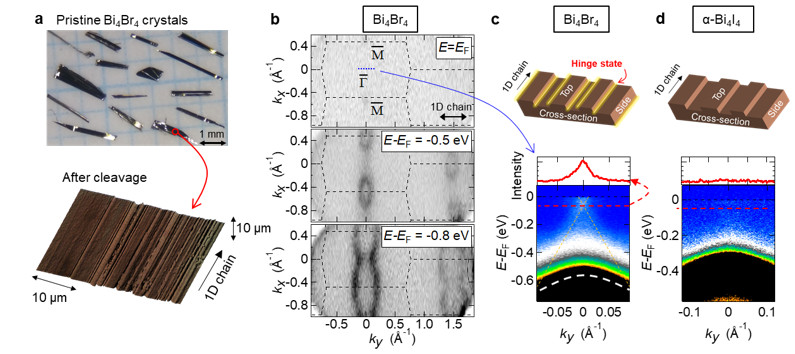Low dimensional van der Waals (vdW) materials have been extensively studied as a platform to generate exotic quantum properties. Advancing this view, a great deal of attention is currently focused on topological materials with vdW structures, which are expected to bring a functionality in topological materials for future spintronics applications. In particular, a higher-order topological insulator (HOTI) in three-dimensions is highly sought after, since spin-polarized electrons are confined in one-dimensional (1D) hinges of a crystal, leading to a non-dissipative spin current that prohibits the mutual scattering of up- and down-spin. To date, only bulk bismuth has been experimentally shown to be in the higher-order topological phase. However, bulk bismuth is a semimetal, and thus it has been desired to find a bulk insulating HOTI in real materials, which allows one to extract the spin current without contamination by bulk conduction.

In the highlighted work, researchers provided evidence for a HOTI state in a vdW-stacked quasi-1D insulator Bi4Br4. Interestingly, various topological phases can be selected in quasi-1D bismuth halides Bi4X4 (X=Br, I) by changing the stacking sequences of Bi4X4 chains. In the form of a two-dimensional sheet consisting of the chains, bismuth halides are expected to be two-dimensional topological insulators (2D TIs) with metallic edge states (Fig. 1). By stacking these sheets to form a three-dimensional crystal as having a single-layer per unit cell (A-stacking: β-Bi4I4), a weak topological insulator (WTI) state will emerge, generating topological surface states on the side surfaces. In α-Bi4I4, the sheets are stacked with slight shifting (AA’-stacking) to form a double-layered structure, which inevitably makes the system a normal insulator, according to the Z2 topological index. While Bi4Br4 also takes a double-layered structure, each layer is alternately rotated by 180° (AB-stacking). In this case, although the Z2 is trivial, the criteria of Z4 invariant expects a non-trivial topology, leading to a HOTI phase, in which metallic hinge states emerge in the bulk band gap. These hinge states, confined in one-dimension, could be the source of dissipationless spin currents.
The Bi4Br4 single crystals are ribbon-like (the top panel of Fig. 2a), reflecting the quasi-1D crystal structure. Importantly, the crystal exposes many terraces and steps in the chain directions on the surface after simple cleavage by a tape, as revealed in the laser-microscope image (the bottom panel of Fig. 2a). This indicates that a bunch of hinges are naturally created on the surface, offering a possibility to detect the strong enough photoemission intensities from the hinge state and uncover its electronic structure.

Figure 2. ARPES results of a higher-order topological insulator Bi4Br4. (a) Photograph of single crystals (top) and laser microscope images of cleaved crystals (bottom). Many hinges appear on the cleaved surface. (b) ARPES maps along ky-kx sheets at different binding energies. Highly anisotropic features are detected. (c) Magnified ARPES image of Bi4Br4. In gap states are detected in consistent with the HOTI phase. (d) No in-gap signals have been detected in a normal insulator α-Bi4I4.
The electronic structure of Bi4Br4 was investigated by angle-resolved photoemission spectroscopy (ARPES) at SSRL beam line 5-2 and at other facilities. Variable photon energies were employed to capture the band dispersions in the 3D momentum space. As shown in Fig. 2b, island-like patterns are observed at the Fermi level (EF); these intensities most likely come from the spectral tail of the unoccupied conduction bands. At higher binding energies, highly anisotropic band structures with a strong dispersion are resolved along the chain direction. In contrast, the bands weakly disperse in the directions perpendicular to the 1D chain, reflecting the vdW-stacking between bismuth halide chains. In addition, a semiconducting gap of ~0.3 eV was observed, which is relatively large as a topological insulator. Additional high-resolution measurements were performed, and metallic in-gap states with quasi-1D Dirac-like linear dispersion was detected, consistent with the prediction for the topological hinge states in the HOTI state (Fig. 2c). The result is in sharp contrast to the case of a normal insulator α-Bi4I4, which shows no indication of the in-gap state (Fig. 2d). The difference in the ARPES results between Bi4Br4 and α-Bi4I4 clarifies the stacking dependence of the topological properties in quasi-1D bismuth halides.
The results presented in this study not only provide experimental evidence for the HOTI state in Bi4Br4, but also propose an excellent functionality of noble topological materials built from vdW-stacking, where the flow of spin currents can be switched by selecting different stacking sequences.
R. Noguchi, M. Kobayashi, Z. Jiang, K. Kuroda, T. Takahashi, Z. Xu, D. Lee, M. Hirayama, M. Ochi, T. Shirasawa, P. Zhang, C. Lin, C. Bareille, S. Sakuragi, H. Tanaka, S. Kunisada, K. Kurokawa, K. Yaji, A. Harasawa, V. Kandyba, A. Giampietri, A. Barinov, T. K. Kim, C. Cacho, M. Hashimoto, D. Lu, S. Shin, R. Arita, K. Lai, T. Sasagawa and T. Kondo, "Evidence for a Higher-order Topological Insulator in a Three-dimensional Material Built from van der Waals Stacking of Bismuth-halide Chains", Nat. Mater. 20, 473 (2021) doi: 10.1038/s41563-020-00871-7




